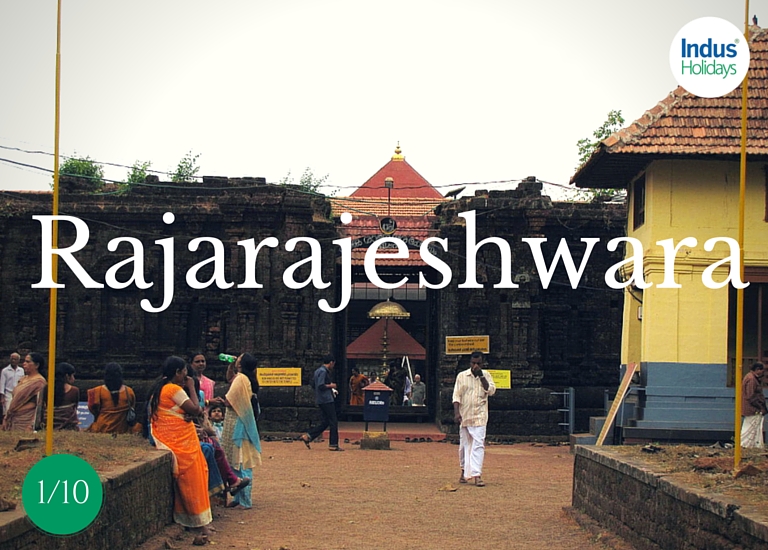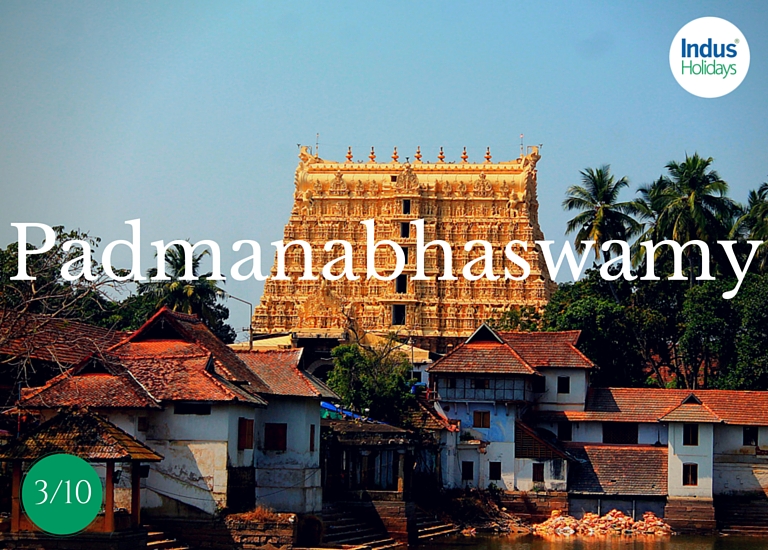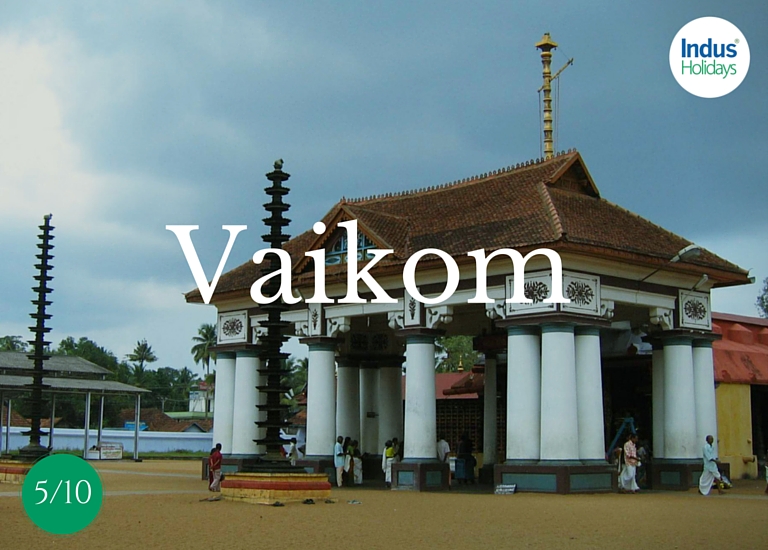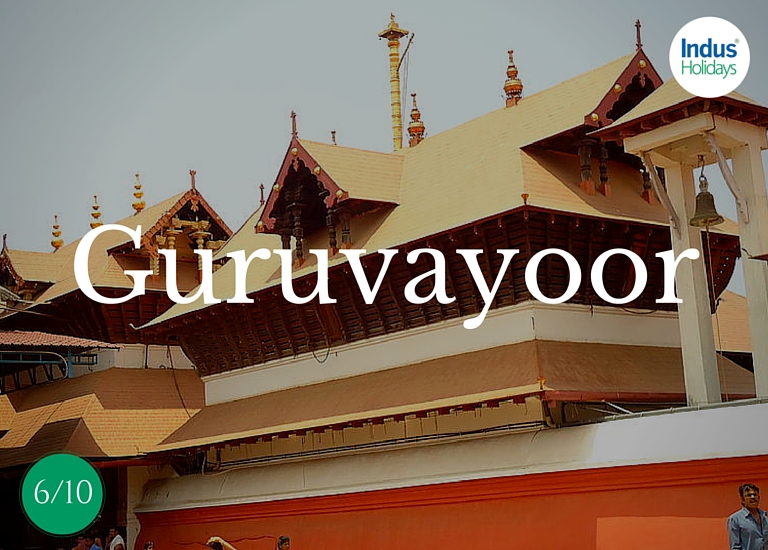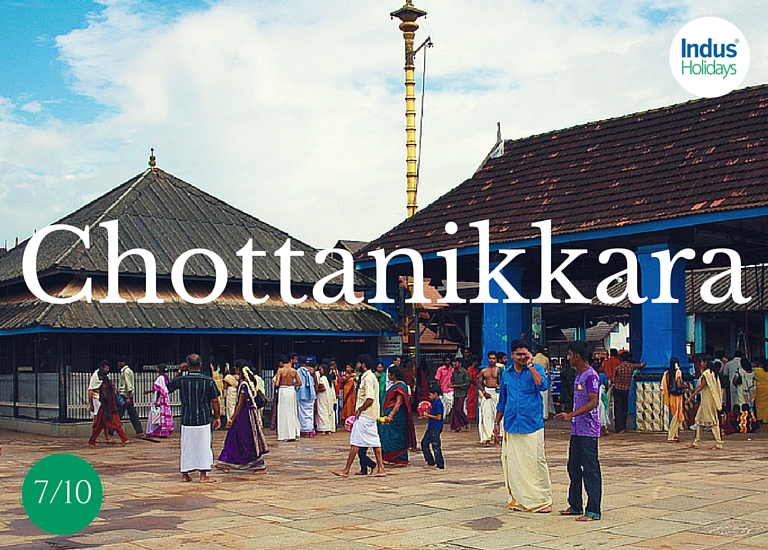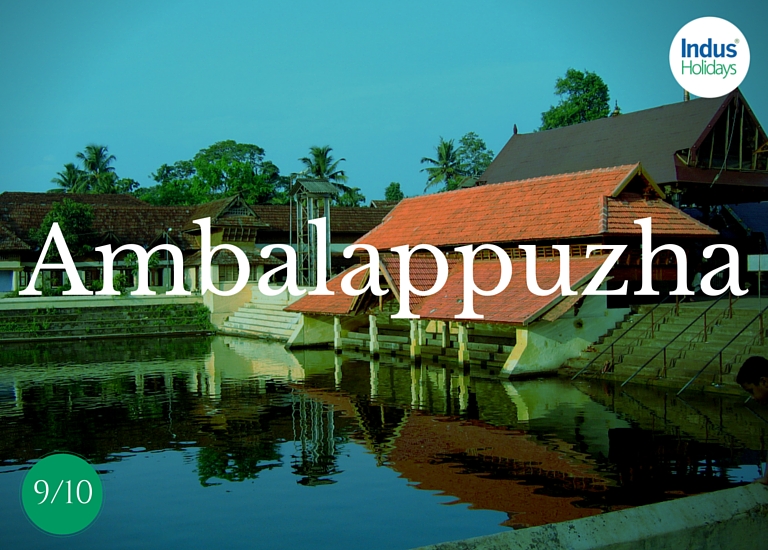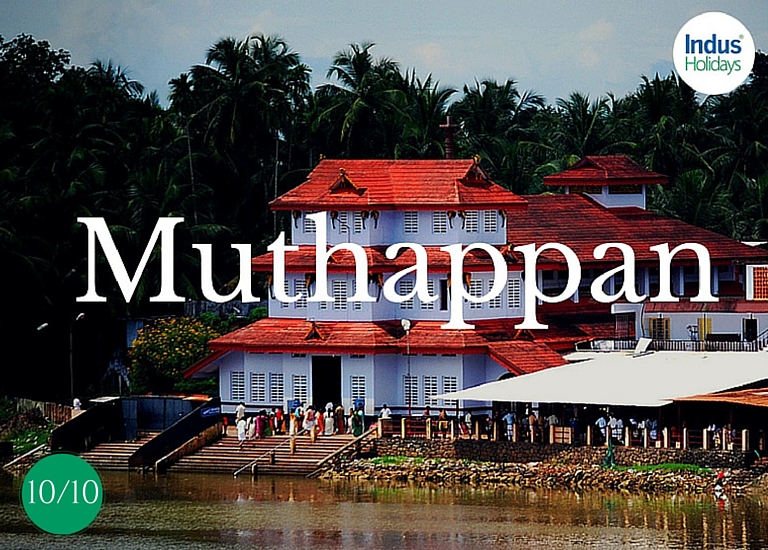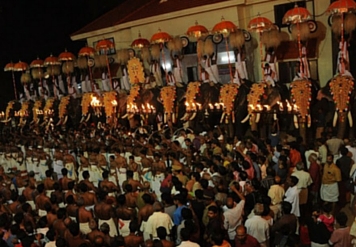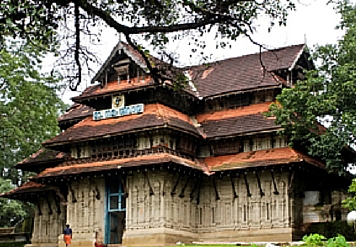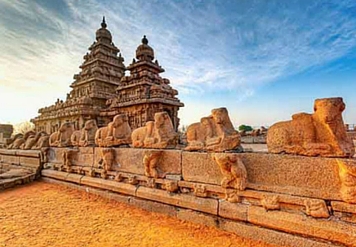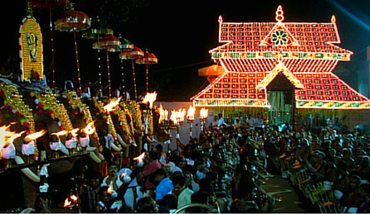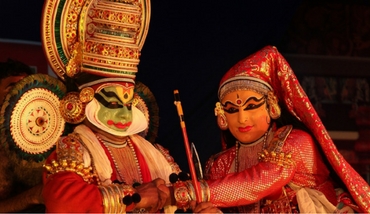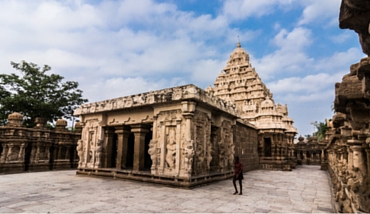- Jun 08,2016
- Post Comments
Famous Temples of Kerala: fascinating places of worship

Indus Holidays
Explorer Team
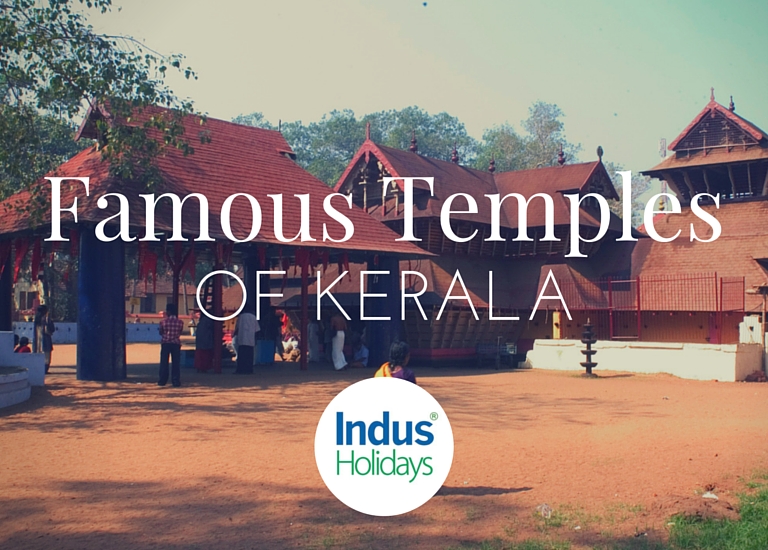
Kerala has more than twenty thousand temples dotting its landscape. From afar, the only sign that marks a typical Kerala temple will be a tall ceremonial flag-mast. This humble scale, an ensemble of simplicity has much to do with the fact that temples here are merged with nature. Being less prone to historic attacks, Kerala’s consecrated sites have a truly distinct feel. As a guide and storyteller to these fascinating places of worship, this article tries to bring out the glory of it all.

From a temple where the presiding deity is crowned emperor with royals functioning as regents to a temple where the goddess is worshipped in three different forms every day, we have fascinating stories to narrate about the temples of Kerala.

While most temples in this region are built in honour of Shiva and Vishnu, the Serpant Gods and Dharmashasta (Ayyappa) also have great importance when it comes to Kerala. This article on the temples of Kerala will discuss ten famous Kerala temples, legendary temple festivals, a couple ancient spiritual circuits and share some practical tips along the way. Before we start, let us give you some context on the regional temple architecture.
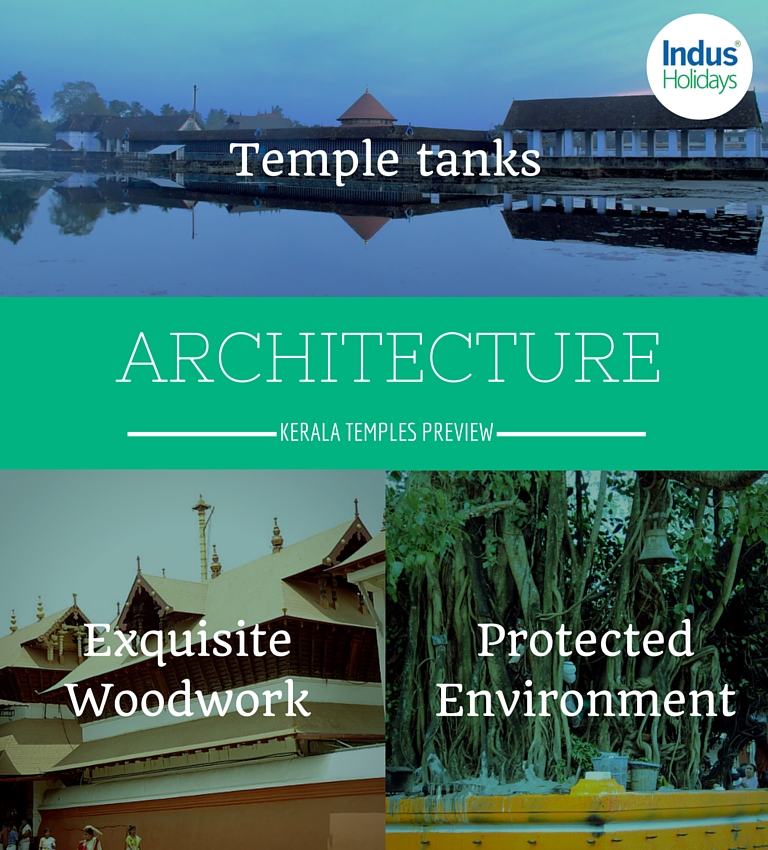
Kerala’s temples are primarily wooden structures that stress horizontal lines rather than tall towers and pillars you would discover in other parts of India. Mostly built during the 15th and 16th centuries, the mural art depicting episodes from Hindu mythology are generally seen on the outer walls of the inner sanctum. The sloping roofs and circular design are elegant solutions to suit Kerala's climatic conditions.

While the artists of Tamilnadu showed their skill on stone by carving magnificent and ornamental sculptures, their counterparts in Kerala had wood as their medium and produced intricate workmanship on simple structures closely integrated with the environment

Kerala’s temples have a distinct space as a social welfare centre, cultural preserver and a site which deeply touch the spiritual facet of local people’s life. Interestingly, the temples have been able to preserve its role making it a truly rewarding travel experience to feel at close quarters. Let us discover insider stories of some of the most famous temples in Kerala starting at Rajarajeshwaram.
Rajarajeshwara Temple, Kannur
Amongst the most prominent shrines in South India, the installation of the Jyothirlinga here is associated with the celebrated sage Agasthya. The traditions in this temple are unique as the lord is worshiped in transcendental form. Unlike other Shiva temples, thulasi leaf is used instead of bilwa leaf, no Dhaara or rudrabhishekam is conducted and even shivarathri has no special significance here. Instead, the sanctum gleams surrounded by an array of deepams (lamps) hanging all around with a golden Kalash (pot) placed at the dome. Ghee pots called Neyyamrithu is the offering here. It is used in daily rituals and to light the ever burning lamp in the sanctum. One can experience the vibrant spiritual power of Lord Rajarajeshwara, the Emperor of emperors.

The jyothirlingam in this unique shrine is worshipped with presence of Lord Shiva as the supreme transcendental power and Goddess Lakshmi together. It is a symbolic amalgamation of both spiritual and material fortunes for the mortal seeker.

Good to know:
- An unusual custom in this temple is that women are allowed entry to the Naalambalam only after 8 pm. It is assumed that after Athazha Pooja, the lord is accompanied by his consort Parvathi and this is the most auspicious time for women to enter and worship the divine couple.
- According to the traditional system of visiting this temple, the devotee first worships Lord Krishna at the shrine of Vasudevapuram on the southern bank of the vast temple tank. It symbolises the essential unity of the lords Vishnu and Shiva.
- The place is considered as most sacred for performing Koodiyattam and Chakyar Koothu. Whenever a new Koodiyattam is being directed, it is first performed at this temple.
- Historically, this temple has another relevance. Whenever a problem is encountered in other temples of South India, prasna (a traditional method of astrological decision making) is conducted outside this temple.
How to reach:
The shrine is located in Taliparamba, Kannur.
Mannarasala Nagaraja temple, haripad
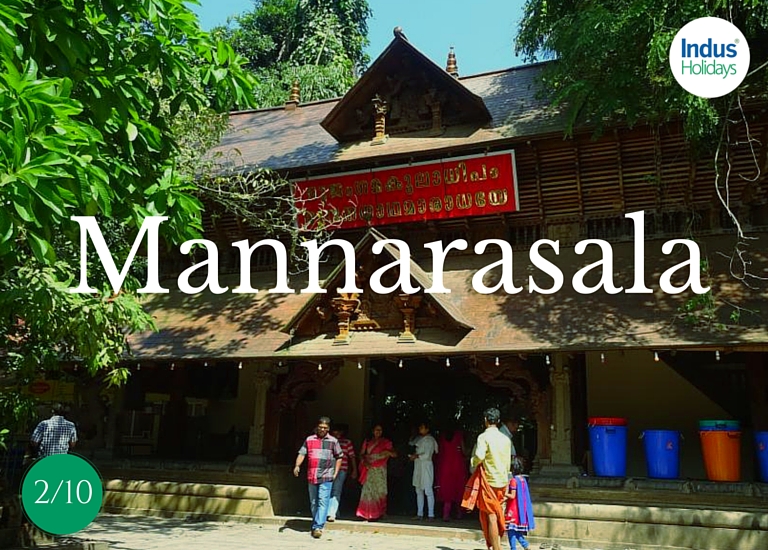
This ancient shrine under the patronage of a Brahmin family is dedicated to the serpant god- Nagaraja and beloved consorts Sarpa Yakshi and Naga Yakshi. While there is no historical account, the mythology states that the temple was founded by Parashurama. At Mannarasala, barren women are believed to be blessed with children and a special turmeric paste available at the shrine is credited with curative powers.

Nestled in a forest glade, this ancient shrine is probably the most famous and largest amongst Serpant God or Nagaraja temples in Kerala

Good to know:
- The temple has about 30,000 granite idols of snakes along the paths and among the trees. These are offerings made by devotees seeking favour of the Nagaraja for their wishes to be fulfilled.
How to reach/Time to visit:
The temple is located at Haripad in Alapuzha District. Mannarasala Aayilyam in October/November is the most celebrated time to visit the temple.
Padmanabhaswamy temple
This iconic landmark after which the city of Thiruvananthapuram is named dates back to the 8th century. Its religious relevance can be gauged from its mention in puranic texts and also as one of the 108 sacred Vishnu temples in India. The temple uniquely incorporates architectural styles from Tamilnadu and Kerala with pillared corridors, its golden mandap and large collection of mural paintings. Lord Vishnu is seen here in ‘Ananthasayanam’, a rare reclining posture on a hooded serpant. The main idol is 18 feet long and can be viewed through three different doors.

Padmanabhaswamy temple is the richest Hindu shrine in the world in terms of assets and is by far the wealthiest place of worship of any kind in the recorded history of the world.

Good to know:
- The lord was crowned as the Emperor of Travancore in the 18th century with the rulers playing the role of regents. This is also why Travancore’s royal crown is preserved inside the temple.
- Talking of rarities, the Vigraha has been fashioned by a complex process known as Katu Sarkara Yogam that is unique to Kerala. In this case specifically, when the support frame for the moola vigraha was prepared, it was lined with 12008 Saligramas brought on elephant back from the Gandaki river in Nepal. As for the outer body covering, parts of the vigraha are in wood and parts of it are in solid gold. All this is masked by the Katu sarkara paste to preserve the vigraha from the onslaught of time.
How to reach:
The temple is located in the heart of Thiruvananthapuram, capital city of Kerala.
Sabarimala: The hill Temple of Lord Ayyappa
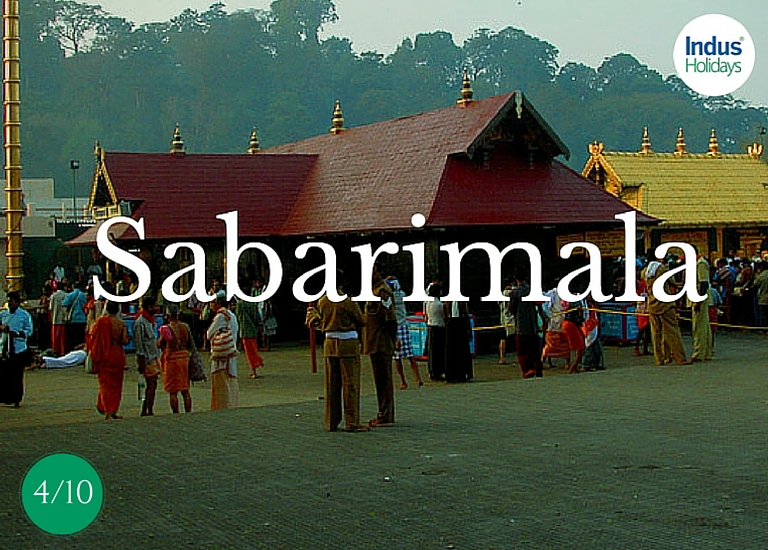
The worship of Shastha forms part of the unique aspects of South Indian belief system. Sabarimala Lord Ayyappan/Dharmashastha is a brahmachari in a state of eternal bliss holding the ‘chinmudra’. The myth goes that in the 12th century, a prince of Pandalam dynasty (considered an avatar of Ayyappan) meditated at the temple and became one with the divine. The worship system here is very different from other temples in Kerala. The temple is open only for a few specified days a year. Pilgrims have to follow a fast for 41 days to cleanse their minds before taking the arduous forest path to the temple. Currently, entry is not allowed to women between 10 and 50 years of age.

Situated in the serene mountain ranges, the Dhasmasastha shrine at Sabarimala is one of the largest annual pilgrimages in the world with an estimated over 100 million visiting devotees

Good to know:
- The uniqueness gathers its voice, as the temple is open to all, irrespective of caste, creed or religion. There is a place near the temple; east to Sannidhanam, dedicated to the Vavar (a sufi and friend of Lord Ayyappa) which is called 'Vavarunada', an epitome of religious harmony.
- The important message given at the temple is the ultimate knowledge that each individual is a God unto himself/herself, Tat Tvam Asi in sanskrit meaning "That Thou Art". Even the deity and the devotee are known by the same name – either Ayyappa or Swamy. This is the only such belief in the world.
How to reach/Time to visit:
The famous hill shrine located 72 km from Pathanamthitta town, 191 km from Thiruvananthapuram and 210 km from Kochi in the state of Kerala. The sannidhanam (temple) is open to devotees only during mandalapooja (November to January), makaravilakku , vishu and the beginning of every month in the malayalam calendar.
Talking of Tamil influence, they are the most innovative temple builders in this part of the world. Does a tour covering the temples of Kerala & Tamilnadu interest you?
Vaikom Mahadeva Temple
Vaikom Mahadeva temple is unique in many respects, one among which being that it was historically held in reverence by both Shaivaite and the Vaishnavaite cult. The story of Ramayana is sculptured on the inner roof of this Shiva temple. The presiding Shivling here is believed to have been established in the ‘Treta Yuga’ with mentions in various ancient Sanskrit texts. The road outside the temple was the venue of the ‘Vaikom Satyagraha’ which made way for entry of all castes to the hindu temples.

This Shiva temple is considered one of the oldest shrines in Kerala where Pooja has not been broken since inception. Needless to mention that it is amongst the most revered temples of the region

Good to know:
- Vaikom Mahadeva Temple is an important part of the trisome with nearby Shiva temples - Ettumanoor Mahadeva Temple and Kaduthuruthy Thaliyil Mahadeva. It is a common belief that that if a devotee worships at these three temples before ‘Ucha pooja’ (around 10 am), all his wishes come true.
- A famous legend of the temple is that of a closed door which was shut when a proud and obnoxious man came to the temple and spat betel leaves in order to disrupt the pooja. He was then mysteriously killed by snake bite and people were ordered by a divine voice to never open the door again.
Best Time to Visit:
Vaikom Mahadeva Temple is located around 31 km from Kottayam in Kerala. The temple is popular for its elephant pageants and traditional art performances during its annual 12 day Vaikkath Ashtami fest (November/December)
Guruvayoor Sree Krishna Temple
Guruvayoor, known as “Bhuloka Vaikunda”, the abode of Lord Vishnu on Earth is a famed Shri Krishna Temple in South India. The temple is of very traditional nature with strict dress codes and entry only to Hindus. Another attraction of the temple is the mural paintings on the walls which have a story to tell. Elephants are an integral part of the temple with the annual festival here beginning with an elephant race. Along with visiting the temple, it is considered customary to visit the adjoining Mammiyoor Shiva temple.

Guruvayoor is one of the most important places of worship for Hindus of Kerala and is often referred to as "Bhuloka Vaikunta" which translates to the "Holy Abode of Vishnu on Earth".

Good to know:
- Guruvayoor temple holds the reputation of hosting the maximum number of marriages and rice feeding ceremony for infants in India
- The idol of Lord Vishnu which is found in Guruvayoor according to mythology was worshipped by Devaki and Vasudeva. One can easily imagine that it must also have been worshipped by God Krishna himself. This is the greatness and glory of this particular idol of God Vishnu – that Vishnu himself had done puja to it in his incarnation as Krishna.
- Along with the darshan you can also plan a trip to Punnathoor Kotta, a fort used to house 64 elephants belonging to Guruvayoor temple.
How to reach/Best Time to Visit:
Located in Thrissur (Kerala), it is hardly a couple of hours from Kochi. Janmashtami (August), Vishu (April) and the 10 day annual festival (Feb-March) are the most important days of worship at Guruvayoor
Already thinking of a trip to Kerala's Temples? Check out our customisable tour package designed on this spiritual circuit.
Chottanikkara temple
With myths and stories associated with every inch of the temple, Chottanikkara Bhagawathy Temple is an embodiment of divine healing and spiritual prowess. A classic example of the wooden sculpture tradition of Kerala, this is one of the most revered places in Kerala. The complex comprises of two temples, Melekkavu and Keezkkavu. While the former temple is of Rajarajeshwari (Chotaanikkara Amma), the latter, a few steps downwards, is the site of Bhadrakali. Devotees throng the temple to get themselves rid of the evil influences of spirits and demons. The Melekkavu temple deity changes form through the day which is also visible in the deity embellishments.

Besides being a classic example of wooden sculpture, this temple dedicated to Goddess Bhagavati has this fascinating tradition of worshiping the deity in three different forms

Good to know:
- In the morning she is worshipped as Saraswati (Goddess of learning) and is therefore draped in white. In the noon she takes on the form of Lakshmi (Goddess of wealth) and draped in crimson while in the evening she is seen in silks and adornments and worshipped as Durga.
- The Goddess rests on a bed of sand with Lord Vishnu at her side and the temple reverberates with the chants of Amme Narayana Badre Narayana.
How to reach/Best Time to Visit:
The Chotanikkara shrine is located about 22 km from Kochi. Thiruvonam, Navarathri Aghosham, Vrishchika Mandala Mahotsavam, Makom Thozhal and Ramayana Masam are the main festivals celebrated in the temple.
Vadakkumnathan temple, Thrissur
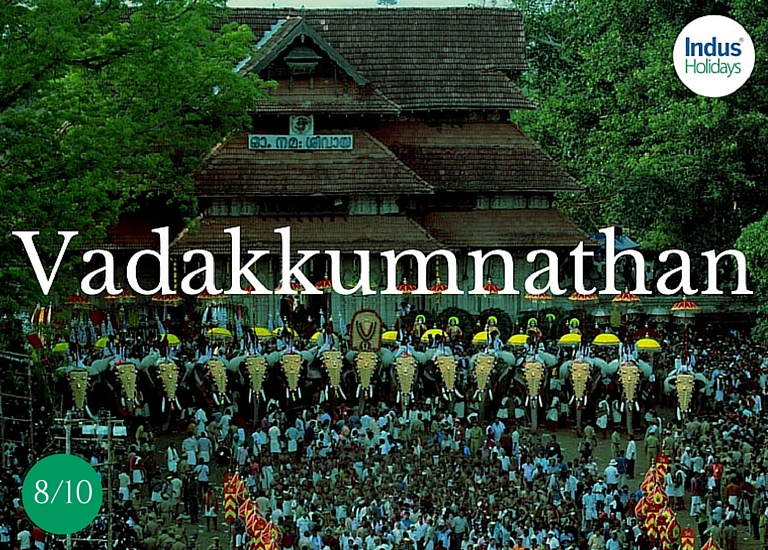
This ancient Shiva temple that is believed to be constructed in the 7th century is fortified in a stone wall enclosing nearly 9 acres. With traditional gopurams in the four cardinal directions, this complex has three principal shines dedicated to Shiva or Vadakkumnathan, Sankaranarayana and Rama. Mural paintings depicting various episodes from Mahabharata can be seen inside the temple. A striking feature of the temple is the Kuttambalam which display vignettes carved in wood and is a theatre hall for staging dramatic art form Kuttu. The temple, along with the mural paintings, has been declared as a National Monument by India

Arguably the grandest amongst the ‘Kerala-style’ architectural temples, this vast fortified complex also plays host to the world famous Thrissur Pooram and the spectacular fireworks which the event prides itself in

Good to know:
- The sanctum has a lingam of Shiva covered in a mound of ‘Abhishekam’ ghee 16 foot high which is formed by daily ablution over years. It is strange that the ghee does not melt in the tropical summers of Kerala or with the heat of hundreds of oil lamps burning nearby. The solidified ghee which is given as Prasad is believed to have curative properties.
- Recently, UNESCO has given the first prize 'Award of Excellence' for the preservation of this heritage site
How to reach/Best time to visit:
The temple opens as early as 3:00 am and is located in the heart of Thrissur town (90 km north of Kochi). The Thrissur Pooram which happens in April is the biggest temple festival on the social calendar of Kerala.
Ambalappuzha Sree Krishna Temple
Constructed in characteristic Kerala architectural style, the Ambalappuzha Sree Krishna Temple is an ancient Hindu temple that was constructed between 15th and 17th century. This temple has a connection with Guruvayur Krishna Temple as it served as a haven for the idol of Krishna from Guruvayoor Temple during Tipu Sultan’s raids of 1789. The idol has Parthasarthi with a whip in the right hand and a Shankhu (conch) in the left hand. The inner walls of Ambalappuzha Sree Krishna Temple have paintings of the 10 incarnations of Lord Vishnu the Dasavatharam

Built in the typical Kerala architectural style, the Ambalappuzha Sree Krishna Temple is famous all over India for Palpayasam, a daily offering of deliciously sweet milk porridge.

Good to know:
- Ottanthullal, a satiric art form created by poet Kunchan Nambiar was first performed on the premises of this temple.
- The temple is associated with Champakulam Moolam snake boat race, the oldest snake boat race in Kerala
How to reach/Best time to visit:
The temple is located at 14 km away from Alapuzha in the heart of Ambalapuzha town. The boat race is during June-July.
Does a leisure tour covering the most famous temples of South India look good? Click for more info.
Parassinikadavu Muthappan
This centre of worship and faith follows many unique practices and rituals, and the temple architecture itself stands testimony to this aspect. The Parassinikadavu Muthappan Temple on the banks of the Valapatnam River promotes the essence of "Vasudaiva Kutumbakam” (The whole world is one family) and attracts people from all sections of the society; irrespective of religion or caste. In Parassinikadavu we can see two idols together; the first wears fish shaped crown representing lord Vishnu and the later wears a green crown with a crescent moon representing lord Shiva. The origin of the temple is connected with the appearance of a child and a string of miraculous incidents that took place in the region.

This is one of the most unorthodox of Hindu shrines which does not follow Satvic Brahmanical form of worship. Here, you not only pray but also interact with a ‘Live’ God through a ritual enactment called Muthappan Theyyam which is performed daily.

Good to know:
- The temple is a popular destination for travellers and pilgrims to savour the charm of Theyyam, a ritual that is performed here on a daily basis. Plan your visit any day in the morning (7.30 am to 9.45 am) or evening (6:30 pm to 8:30 pm) to witness this ritual.
- The customary offerings to appease the rebel god of this temple are roasted fish, wild meat and toddy.
Best Time to Visit:
The temple is located 20 km from Kannur, northern Kerala. The Muthappan Thiruvoppana Mahothsavam (Feb/March) and Puthari Thiruvappana festival (Dec/Jan) are special times to visit.
While the above section broadly covers some famous temples, no article on the temples will be complete without a mention of some unique ancient centres of worship and some remarkable temple festivals which mark the calendar year. Read On!
Heritage temples & Temple Festivals of Kerala
The centrality of temple tourism to the Kerala traveller goes way beyond these ten famous Kerala temples. We couldn’t possibly do justice to all the temples of the region. However, there are some ancient heritage temples that we would like to briefly cover in this context and also some of the famous temple related festivals.
Ancient Heritage temples

Thirunelli
Probably the only temple in the world where devotees perform all rituals — from birth to death. This ancient Vishnu temple on the foothills of Bhramagiri peak is an important religious spot where the living pray for their dead ancestors. A bath in the Papanasini river which flows close to the temple is believed to wash away one’s sins.
Location: Wayanad (130 km from Kozhikode)
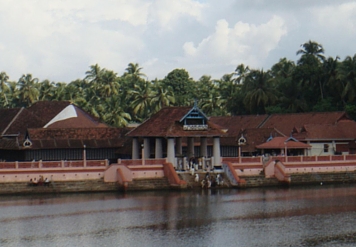
Thriprayar Rama Temple
This Hindu temple is one among four temples dedicated to Rama and his brothers in central Kerala (Nalambalam Yatra). The image of Rama resembles the Chaturbhuja Vishnu form with four arms, bearing a conch (Panchajanya), a disc (Sudarsana), a bow (Kodanda) and a garland respectively.
Location: 22 km from Thrissur
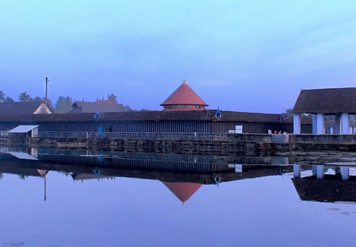
Koodalmanikyam
A distinctive feature of Koodalmanikyam temple is that there is only one Prathista, that of Bharata (Lord Rama’s brother). This ‘Nalabambalam Yatra’ temple is a marvel with three very impressive gateways, a round shaped Sanctum Sactorum, a majestic Koothambalam and carvings in wood and stone on the walls.
Location: Near Irinjalakuda (30 km from Thrissur)
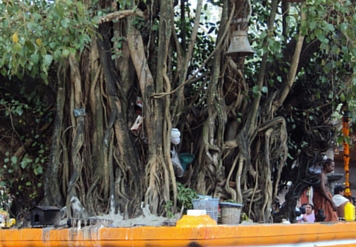
Oachira
In a state known for its extravagant temples, the Oachira Parabrahma Temple is a unique exception. For one, there is nothing that resembles a conventional temple here. A banyan tree with a base foundation serves as the sanctum sanctorum. All kinds of poojas are performed right here open to the elements.
Location: Kollam, South Kerala

Ananthapura Lake Temple
Dedicated to Lord Vishnu, Kasaragod’s Ananthapura Lake Temple dates back to the 9th century and is the moola sthalam (original seat) of Padmanabhaswamy. Located in the middle of the picturesque Lake, this unique temples outer walls have murals on the vedas. The temple’s mysterious guardian crocodile is also famous.
Location: 18 km from Kasaragod (North Kerala)

Lokanarkavu temple
Lokanarkavu temple is a 1500 years old family temple of the Aryan Nagariks. Associated with the heroes and heroines of the Vadakkanpattu or northern ballads, the temple combines an arresting simplicity and a legendary aura. The candid murals and carvings here are a delight to art lovers.
Location: 4 km from Vadakara (North Kerala)
Temples famous for their festivals
The annual festival at Arattupuzha is also termed as the mother of all pooram festivals in Kerala, due to its sheer magnitude and grandeur. The pinnacle of excitement and devotion during the seven-day festival is obviously the last two days with caparisoned elephants and fireworks.
Location: Arattupuzha Sastha Temple, Thrissur
Estimated date: Between end-March and mid-April
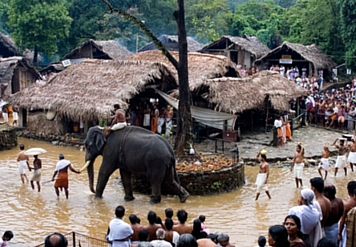
Kottiyoor Festival
This important Lord Shiva shrine is located in the deep forest. It is interesting to note that there is no physical temple structure except for a Shiva linga. The annual festival attracts lakhs of devotees every year during the "Vaisakha Maholsavam”. It is the only temple festival during monsoons.
Location: Kottiyoor Mahadeva Temple, Kannur
Estimated date: Between mid-May and mid-June
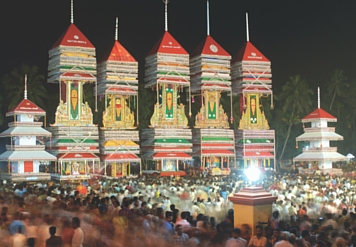
Chettikulangara Bharani
What makes the festival stand out is a spectacular event called Kettukazhcha. It is a ceremonious procession of brightly decorated structures. Among the decorated structures, the bigger ones are assumed to be horses and the smaller ones to be chariots. The cultural performances are the highlights of this spectacular pageant.
Location: Chettikulangara temple, Mavelikkara, Alappuzha
Estimated date: Between mid-Feb and mid- March

Ezhara Ponnana
One of the most elegant sights associated with the temple festivals of Kerala is the 'Ezhara Ponnana' procession. 'Ezhara' means seven-and-half and 'Ponnana' means golden elephant. Each of the seven elephants is two feet high and the eighth one is of one foot only. Hence they are together called seven-and-half elephants.
Location: Ettumanoor Mahadeva Temple, Kottayam
Estimated date:10-day festival in February/March

Kalpathi Ratholsavam
Kalpathy Ratholsavam, the Chariot Festival, is based on vedic Tamil Brahmin culture. During the festival week, the deity from Viswanatha Swami Temple is taken out and installed in the chariot. Thousands of devotees drag the huge, intricately carved temple chariots bedecked with flowers, fruits and flags through the streets.
Location: Sree Viswanatha Swami Temple, Palakkad
Estimated date: November
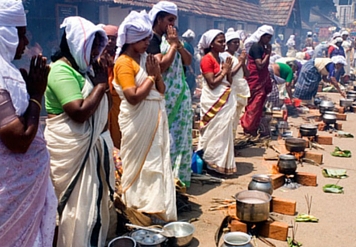
Attukal Pongala
This temple is best known for the annual Attukal Pongala festival (February-March) in which over a million women participate. The festival holds a record for being the single largest gathering of women for a religious activity. The offering of Payasam (a sweet dish) is cooked in makeshift brick stoves and earthen pots.
Location: Attukal Bhagavathy Temple, Trivandrum
Estimated date: February-March
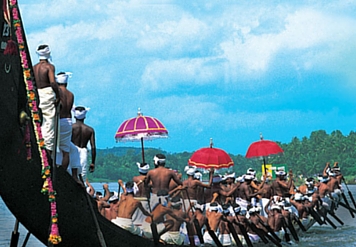
Vallasadhya
The Aranmula Vallasadhya is a ritual offering to the deity Lord Parthasarathy in which the oarsmen of the snake boats are offered a feast. With over 70 dishes, it is probably one of the largest vegetarian feasts in India. An event that combines ritual offerings, sports and music, the elaborate feast lasts for more than two hours.
Location: Shri Parthasarathy temple, Aranmula
Estimated date: July-August
Things to keep in mind when you visit Kerala Temples
- Most temples in Kerala give access to people who profess Hindu faith. Unlike other parts of India, even the outer courtyards of temples are open to only Hindus. Noteworthy exceptions are the likes of Sabarimala temple. So pay heed to access rules as you are expected to respect that.
- Some temples follow strict traditional dress codes too (like Guruvayoor and Padmanabhaswamy temple). You can purchase the mundu (traditional wear) required for entry from the temple premises itself.
- Expect crowds, darshan may take a couple of hours of waiting in queues depending on the temple closing patterns and special poojas of the day. So plan you tour accordingly.
Tailpiece
When it comes to temples, it is about heritage, art forms, belief systems, architecture and lifestyle all wound together in a multi-dimensional experience. Each time we go or hear about experiences of travellers we feel it just get more layered.

Unlike sightseeing destinations, the temples are living museums and that is why even the experiences end up having dimensions beyond what can ever be planned for.

We hope you found this article useful for your travel planning. Do share your thoughts with us by commenting below. Words can only do so much; the rest is for you to experience. Your moment is waiting!
Related Tour Packages
Related articles
New Articles
-
1
Apr 23,2019
Nehru Trophy Boat Race 2019: Booking Options
-
2
Apr 19,2019
Nehru Trophy Boat Race: The essential guide
-
3
Jan 19,2019
Everything you need to know about an Ayurveda Holiday in Kerala
-
4
Aug 10,2018
Thinking about Kerala for your next holiday? Start right here!
-
5
Jul 09,2018
Ten secrets to a fascinating backwater experience: Discover it!
Send An Enquiry
WE ARE SOCIAL, LET’S CONNECT
